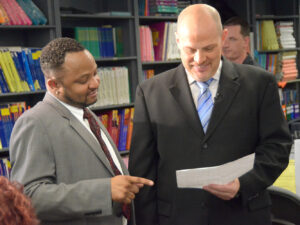 The Dial-A-Teacher Program, a joint project of the United Federation of Teachers and the New York City Department of Education, has been in operation for more than 35 years. It began in January 1980 as a pilot program in 17 schools in eight districts. Five teachers, one of whom was proficient in Spanish, were hired to field students’ homework questions. Students throughout the city soon realized it was a place to call if they were stumped by a homework question.
The Dial-A-Teacher Program, a joint project of the United Federation of Teachers and the New York City Department of Education, has been in operation for more than 35 years. It began in January 1980 as a pilot program in 17 schools in eight districts. Five teachers, one of whom was proficient in Spanish, were hired to field students’ homework questions. Students throughout the city soon realized it was a place to call if they were stumped by a homework question.
By 1986, the program had expanded to include all elementary schools, thanks to funding from the City Council. The program provides free homework assistance for parents and students directly over the telephone, from Monday through Thursday, from 4 to 7 p.m. The teachers who answer the phones average over 20 years of experience per person in the New York City public school system. The program starts when school opens in September and continues throughout the school year.
 The staff consists of approximately 50 teachers, one program coordinator, one field coordinator, one administrative assistant, and office assistants. Many of the teachers are bilingual, so Dial-A-Teacher is able to assist parents and students in 10 languages, including Armenian, Bengali, Chinese, English, French, Haitian-Creole, Korean, Russian, Spanish and Tagalog.
The staff consists of approximately 50 teachers, one program coordinator, one field coordinator, one administrative assistant, and office assistants. Many of the teachers are bilingual, so Dial-A-Teacher is able to assist parents and students in 10 languages, including Armenian, Bengali, Chinese, English, French, Haitian-Creole, Korean, Russian, Spanish and Tagalog.
Over the years, the Dial-A-Teacher program has expanded and now includes teachers proficient in all secondary school subjects so that calls can be handled whatever the subject, in grades from K–12.
DAT teachers never give students the answers to homework problems. Concepts are re-taught over the phone so a student fully understands the topic and the problem. DAT gives students the opportunity to talk one-on-one with a teacher in a way that the average classroom, with more than 26 students per class (and up to 33 students in middle school and 34 in high school), may not allow.
Most calls come from students, but approximately 15% of calls come from parents. Sometimes parents will call to have a concept or directions explained to them so they can be er help their children with homework. DAT is so successful because of its simplicity: A child or a parent with a question finds homework help available with one simple phone call.


